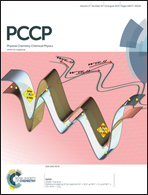Calixarene assembly with enhanced photocurrents using P(SNS-NH2)/CdS nanoparticle structure modified Au electrode systems
Abstract
Two novel calix[n]arene-adorned gold electrodes producing high photocurrent intensities were successfully constructed by embedding gold electrode surfaces with both P(4-(2,5-di(thiophen-2-yl)-1H-pyrrol-1-yl)benzenamine) conducting polymer and 4-mercaptoboronic acid-functionalized semiconductor CdS nanoparticles to facilitate the binding of calix[n]arene sulfonic acids with nanoparticles. This structure enabled an electron transfer cascade that both induced effective charge separation and efficiently generated photocurrent. The prepared electrodes were used to generate photocurrent by relying on the host–guest interactions of guests Br3− and I3−, which if positioned well in the system was able to fill electron–hole pairs of CdS nanoparticles. As a result, host calixarene derivatives crucially held Br3− and I3− ions at a substantial distance from CdS nanoparticles. Furthermore, the effects of various calixarenes on the photocurrent obtained indicate that the generation of photocurrent intensities by the system depends on the cavity sizes of calixarene derivatives, which provide an essential center for Br3− and I3− ions.


 Please wait while we load your content...
Please wait while we load your content...